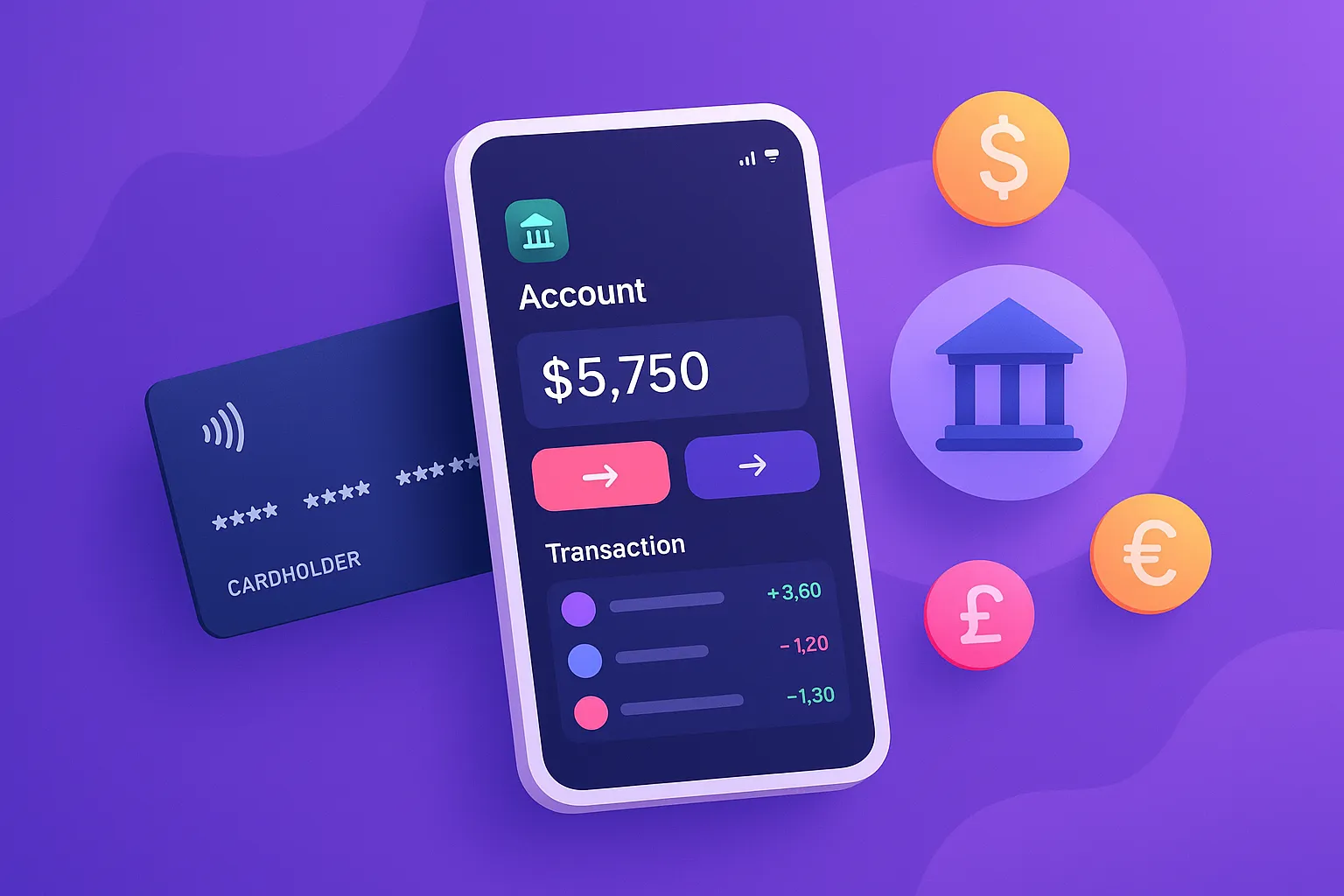Business model of Neobank have completely redefined the way people manage their money. Unlike traditional banks with physical branches, neobanks operate 100% online, offering streamlined financial services through apps and web platforms.
Their business model of Neobanks worth studying because it shows how technology-first companies can disrupt an old industry, acquire millions of users fast, and generate revenue through innovative digital channels. If you’re planning to launch your own neobank or fintech app, understanding this model will give you the blueprint to build, scale, and monetize effectively.
What is Neobank & How It Works
A Neobank is a fully digital bank with no physical branches. It solves the hassle of outdated banking by offering simple, user-friendly financial services directly on your smartphone. These platforms combine sleek design with smart technology to deliver fast, transparent banking experiences. From instant account opening to real-time spending insights, everything happens seamlessly within the app.
What Problem Does a Neobank Solve?
Traditional banks often have:
- Complicated paperwork
- Hidden fees
- Outdated digital experiences
Neobanks fix this by providing:
1 .Transparent pricing
2 . Fast onboarding
3 . Real-time account management
Who Uses Neobanks?
Neobanks primarily serve:
- Millennials and Gen Z who prefer mobile-first solutions
- Freelancers and gig workers needing flexible banking
- Small businesses looking for cost-effective financial tools
- Underbanked populations underserved by traditional banks
How Does a Neobank work Operate?
Here’s how the typical neobank works behind the scenes:
- Digital-Only Accounts: Users open accounts in minutes via app or website.
- Partnered Infrastructure: Most neobanks partner with licensed banks to handle deposits and compliance.
- Card Issuance: They issue debit or prepaid cards through payment networks like Visa or Mastercard.
- Revenue Engines: They monetize through interchange fees, subscriptions, lending, and value-added services.
This model keeps overhead low while scaling rapidly to serve thousands or even millions of customers.
Read More : What is a Neobank App and How Does It Work?
Target Audience for Digital Banks
Neobanks are laser-focused on digitally savvy customers who value convenience, transparency, and control. Here are the core customer segments that drive their growth:
Young Professionals
Millennials and Gen Z customers who expect seamless mobile experiences, instant payments, and smart budgeting tools.They prefer managing all their finances through a single app instead of juggling multiple accounts.This group is highly engaged and quick to adopt new features like spending insights and savings goals.
Freelancers & Gig Workers
Independent workers who need flexible accounts, faster payouts, and tools to manage irregular income.Traditional banks often lack tailored solutions for variable cash flow, making neobanks an attractive alternative.
Small Business Owners
Entrepreneurs and micro-businesses using neobanks for low-cost business accounts and easy expense management.These users look for quick account setup, low fees, and integrations with their accounting software.Neobanks also help them separate personal and business finances without the bureaucracy of legacy banks.
Underbanked Populations
People without access to traditional banking due to high fees, credit issues, or geographic limitations.Neobanks provide simple onboarding and lower barriers to entry, giving these customers their first digital banking experience.This inclusion builds brand loyalty and opens up new revenue opportunities.
Digital Nomads & Travelers
Users looking for multi-currency accounts and low foreign transaction fees to manage money across borders. They value instant currency conversion, global ATM access, and transparent rates with no hidden charges. Neobanks help them stay financially agile wherever they are in the world.
Features that Support the Business Model
Neobanks rely on powerful, user-centric features that not only attract customers but also create revenue opportunities. Here are the core features that fuel their success:
Instant Digital Onboarding
Quick sign-up with eKYC verification so users can open an account in minutes without paperwork.This frictionless experience is a major draw for customers used to instant digital services.It also reduces operational costs and speeds up customer acquisition compared to traditional banks.
Smart Budgeting & Analytics
Visual spending insights and budgeting tools that keep users engaged and increase app stickiness.Users can categorize expenses, set savings goals, and get alerts to avoid overspending.These tools help build trust and position the neobank as an everyday financial companion.
Debit and Virtual Cards
Physical and virtual cards drive interchange fee revenue on every transaction.Customers enjoy secure payments online and in-store, plus added features like card freezing and spending limits.Branded cards also boost brand visibility and loyalty in a competitive market.
Peer-to-Peer Payments
Instant transfers between users boost engagement and keep funds circulating within the platform.This reduces reliance on external payment networks and increases transaction volume.It’s especially popular with freelancers, friends, and families splitting expenses.
Personal Loans & Overdrafts
Short-term credit options generate interest income and support users’ liquidity needs.Neobanks use data-driven credit scoring to offer tailored lending products with transparent terms.This creates an additional revenue stream while helping customers manage cash flow.
Savings Pots & Goals
Micro-saving features encourage deposits and higher account balances.Users can create named pots for specific goals like vacations or emergencies, making saving feel achievable.
Higher deposits also strengthen the neobank’s balance sheet and lending capacity.
Subscription Tiers
Premium plans unlock perks like higher withdrawal limits, insurance, and exclusive card designs.Recurring subscription revenue helps stabilize cash flow and fund new product development.Tiers also encourage customers to upgrade as their financial needs grow.
Each feature plays a strategic role in driving transactions, retaining users, and unlocking diversified revenue streams. Neobanks combine these elements to deliver a compelling alternative to legacy banking.
Read More : Best Neobank Clone Scripts in 2025: Features & Pricing Compared
Revenue Streams of Neobank
Neobanks typically blend multiple monetization strategies to build sustainable revenue. Below is a clear breakdown of how they make money:
| Revenue Stream | How It Works |
| Interchange Fees | Earned from every card transaction processed through Visa or Mastercard. |
| Subscription Plans | Monthly fees for premium features like insurance, higher limits, and exclusive cards. |
| Lending & Overdrafts | Interest income from personal loans, credit lines, or overdraft facilities. |
| FX & Cross-Border Fees | Charges on currency conversion and international payments. |
| Partner Offers & Referrals | Commissions from recommending financial products, insurance, or investments. |
| Business Accounts | Fees for business banking services and expense management tools. |
Quick Overview
- Interchange Fees: Every time users swipe their cards, the neobank earns a percentage of the transaction.
- Subscriptions: Premium tiers generate recurring revenue and improve predictability.
- Lending: Lending products can become a major profit center.
- FX Margins: Cross-border transactions yield additional margin.
- Referrals: Third-party partnerships drive non-core revenue without much operational overhead.
These revenue streams combine to create a scalable, diversified business model.
Read more : Revenue Model of Neobank: How Digital-Only Banks Make Money
Cost Structure Behind Digital Banks
While neobanks save money by avoiding physical branches, running a digital bank still involves significant operating costs. Here are the main expenses involved in sustaining and growing this type of app:
- Technology & Infrastructure
Costs to build, maintain, and scale secure mobile apps, cloud hosting, and banking platforms. - Compliance & Licensing
Regulatory expenses for KYC/AML compliance, audits, and partnering with licensed banks. - Customer Support
24/7 chat and phone support to handle account issues and build trust. - Marketing & User Acquisition
Paid ads, referral incentives, and promotions to acquire and retain customers. - Card Issuance & Processing
Manufacturing physical cards and processing transactions through payment networks. - Fraud Prevention
Advanced security systems and teams to detect and mitigate fraud. - Product Development
Continuous investment in new features and upgrades to stay competitive.
These costs can be optimized through strategic partnerships and by scaling user volumes, but they remain critical considerations for any founder launching a neobank.
2024–2025 Innovations or Updates
Neobanks are evolving fast to stay ahead of customer expectations and regulatory shifts. Here are some of the most impactful trends and updates shaping their business model in 2024–2025:
- Embedded Finance
Many neobanks now offer embedded financial products—like insurance, investments, or BNPL—directly in their apps. This helps diversify revenue and increase user engagement. - AI-Powered Personal Finance
Advanced AI tools are being integrated to provide personalized budgeting tips, savings recommendations, and credit insights in real time. - Green Banking Initiatives
New features allow customers to track their carbon footprint and support climate-friendly projects, appealing to sustainability-focused users. - Crypto Integration
Select neobanks are adding wallets, crypto trading, and stablecoin accounts to attract younger demographics. - Dynamic Subscription Models
Flexible subscription tiers with customizable add-ons let users pay only for the services they need, improving conversion rates. - Enhanced Security Layers
Biometric authentication, real-time fraud alerts, and adaptive risk scoring have become standard.
These innovations help neobanks increase lifetime value, broaden their customer base, and maintain a strong competitive edge.
Takeaways for Startup Founders
If you’re thinking about building a neobank or any fintech platform, there are crucial lessons to learn from the neobank business model:
- Solve a Specific Pain Point
The most successful neobanks start by tackling a clear frustration—like high fees or slow transfers—and expand from there. - Design for Trust and Simplicity
Banking is sensitive. An intuitive app experience, clear pricing, and strong security are essential to win user confidence. - Diversify Revenue Early
Don’t rely solely on interchange fees. Incorporate lending products, subscriptions, and partner offers to stabilize income. - Prioritize Regulatory Readiness
Compliance and licensing can slow you down. Plan these costs and timelines into your roadmap. - Embrace Continuous Innovation
Stay ahead by adding AI features, crypto options, and sustainable banking tools that appeal to emerging customer demands.
Read more : Reasons startup choose our neobank clone over custom development
Working with Miracuves gives you a shortcut to launching a powerful neobank faster. We offer ready-made neobank solutions you can customize and deploy, so you can focus on growth instead of reinventing the wheel.
Explore how our Neobank Development services help founders bring fintech ideas to life with lower costs and faster time-to-market.
Conclusion :
Neobanks have proven that with the right mix of technology, trust, and innovative revenue streams, it’s possible to disrupt even the most established industries. Their business model—anchored in low overhead, smart partnerships, and user-first design—offers a blueprint for any founder aiming to build a modern financial platform.
If you’re ready to create a neobank that stands out and scales fast, Miracuves is here to help. We specialize in ready-made neobank solutions you can customize to launch confidently and start acquiring users right away.
Let’s build your neobank together. Contact Miracuves to get a demo or learn more about our development services.
FAQs :
1. How do neobanks differ from traditional banks?
Neobanks operate 100% online without any physical branches. They typically offer faster onboarding, lower fees, and more user-friendly digital experiences. In contrast, traditional banks have brick-and-mortar locations and often more complex processes.
2. Are neobanks profitable?
Many neobanks focus first on growth and user acquisition. Profitability comes as they scale, diversify revenue through lending and subscriptions, and optimize costs.
3. What are the biggest challenges when launching a neobank?
The main challenges include regulatory compliance, building user trust, and standing out in a crowded market. Partnering with experienced fintech developers can help overcome these obstacles faster.
4. Can I integrate crypto features into my neobank app?
Yes. Many neobanks are adding crypto wallets, trading, and stablecoin support. This is an effective way to attract younger users and diversify revenue.
5. How can Miracuves help me build a neobank?
Miracuves provides customizable, ready-made neobank app solutions, including core banking features, KYC workflows, and payment integrations—so you can launch faster and focus on growth.
Related Articles :
- How to Build a Digital Bank Like a Neobank: A Practical Guide for Startups
- Business Model for Digital Banking: How Neobanks and BaaS Platforms Monetize in 2025
- Pre-launch vs Post-launch Marketing for Neo Bank Startups | Miracuves
- How to Develop a Digital Banking App in 2025 | Miracuves Neobank Builder








